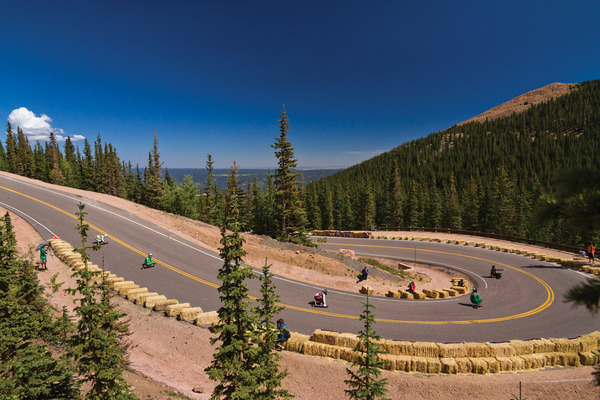The Local newsletter is your free, daily guide to life in Colorado. For locals, by locals.
Just before dawn, atop one of the highest paved passes in North America, 20-year-old Coloradan Zak Maytum climbs out of a van wearing a skintight black-and-red leather body suit, a Darth Vader–esque helmet, and Kevlar gloves. The air is calm. He can see each breath as he greets the three similarly dressed members of this morning’s “Dawn Patrol” near a sign marking the mountain’s 12,000-foot summit.
They pause to take in the jagged, snow-capped panorama barely lit by the rising sun and survey the smooth road stretched out before them. There isn’t a motorist or park ranger in sight. They each lower their visors, push off, tuck, and fall into a single-file line. Soon, they’re careening down hairpin switchbacks framed by precipitous 1,000-foot drops faster than cars dare travel. At one point, they whiz past an oncoming Jeep. Their mode of transportation: A 10-inch wide slab of wood attached to four polyurethane wheels.
“It’s like flying,” explains Justin DuBois, a 35-year-old restaurant owner turned downhill longboarder who’s filming this morning’s covert 11-minute ride with his helmet cam. Later, DuBois will set the footage to music and post the video online for the growing hordes of downhill longboarding fans—an unusual, and yet quintessentially Colorado, sport. “You’re standing on a wooden plank, going 60 miles an hour with no brake and no engine,” DuBois says. “All you have is the wind coming at you.”
Almost 40 years ago, the U.S. Skateboarding Association staged “the world’s first downhill skateboarding race” on a dizzyingly steep road in Long Beach, California. By 1978, the legendary Signal Hill Speed Run was drawing TV crews and 5,000 spectators who lined the course, beers in hand, for a look at the carnage. The boards were unstable, with hard wheels and little traction, and the riding styles were notoriously reckless. At one point, the Los Angeles Times reported that the race had been delayed because all available ambulances were transporting skateboarders to the hospital. Even a young spectator was rushed to the ER after a stray board clipped his leg. Eventually, sponsors fled and the sport went underground, only to resurface for a brief, underwhelming showing at the 1998 X Games.
But downhill would come back. Around 2005, just as the skateboard industry was hitting the skids, manufacturers started rolling out boards with longer, more stable decks and big, soft wheels that spit out gravel and absorbed the shock of rough pavement. The boards appealed to a new breed of riders with little interest in the freestyle tricks made famous by Tony Hawk in the 1990s. Instead, they simply wanted to get from point A to B. For skateboard shops, “longboarding kept the lights on,” says Michael Brooke, publisher of Concrete Wave Magazine. In places such as Colorado, where the lure of gravity and adrenaline beckoned, the downhill scene exploded. Some of these pioneers came from the bohemian surfing or snowboarding culture, drawn to the freeing sensation similar to riding a wave or carving powder. Others, like Maytum—a neatly coiffed and clean-shaven entrepreneur—had an affinity for motorcycles and race cars. Longboards were just a different way to go fast.
After experimenting with skate parks and slalom courses, Maytum, then 16, found himself at the top of a mountain pass in January 2008, a fierce wind at his back. He pushed off and sped down the hill. “Instead of going to a road and setting up cones, you’re battling the terrain that’s already there,” he says. Maytum already had started crafting longboards from birch plywood in his parents’ Boulder garage. He also had begun cutting up used skateboard wheels with a saw to create custom bushings (polyurethane rings that fit into skateboard trucks and are designed to help riders maintain control while turning at high speeds). Maytum sold the bindings to his friends and eventually launched his own company, Venom Skate Products.
With equipment improving and riding styles maturing, longboarders began gathering on remote Colorado roads for loosely organized “outlaw races,” spreading the word via Facebook posts and on skateboarding websites. As the crowds grew, older riders, including DuBois—who lives in Estes Park—took the initiative to get a permit, rent some hay bales, and host a legal race on a closed road. DuBois’ Buffalo Bill Downhill Bloodspill, founded in 2009 on Lookout Mountain Road in Golden, grew to 220 racers and 1,000 spectators in 2012, putting Colorado on the map as a hub for the nascent sport. (Canadian rider Mischo Erban is rumored to have set a new world record for speed, 80.8 mph, in a canyon in northern Colorado.)
Today, Maytum makes a living selling high-end downhill longboard components and traveling the world to compete in the obscure sport’s growing list of events. “It is the simplest form of skateboarding,” he says. “To go to the top of a hill and race down.” There’s only one problem: In order to train, riders must break the law.
On the afternoon of January 20, a resident of the Lakeshore Park subdivision at the top of Flagstaff Road in Boulder rounded a steep hairpin corner in a Honda on his way up the canyon and saw a group of dark figures coming at him. The riders had crossed the yellow line into his lane, as they sometimes do in an effort to gain speed on the curves. The driver swerved to avoid them and then called police. When the cops arrived, the riders were gone, likely having hopped a guardrail and disappeared into nearby open space.
Law enforcement officials say incidents like this have become increasingly common around Colorado during the past few years. In 2013, the Boulder County Sheriff’s Department alone fielded 20 calls, significantly more than the previous year. State Patrol officers and park rangers (the latter only have authority in parks) are also issuing tickets. “It is and always has been illegal,” says Boulder County sheriff Joe Pelle, noting that a skateboard is considered a “toy on the road” on all Colorado roadways, which carries a $15 fine. “What has changed is the number of complaints.” Both callers and deputies say their main concern is for the safety of the riders.
In an incident captured on video, 22-year-old Boulderite Nate Ryan was traveling 55 miles per hour down a mountain pass in 2013 when he hit an elk and was knocked unconscious. “The last thing I remember was his fur hitting my neck,” says Ryan, who walked away with an injury to his back, whiplash, and a concussion. Colorado racer Kawika Omoto shattered seven vertebrae when he crashed into a guardrail just west of Golden. In one tragic case, 27-year-old competitor Glenna Evans died in 2010 after she collided with a car outside of North Vancouver, British Columbia.
Such accidents have prompted lawmakers from Vancouver to Portland to Laguna Beach to propose bans in areas where skateboarding is still allowed. In Colorado, where it is already banned, some officers have suggested boosting fines for repeat violators. Maytum, now ranked fourth in the world and gearing up for what could be his most lucrative season yet, isn’t taking any chances. “I have personally been told that if they catch me again, I will spend the night in jail.”
The number of legal opportunities to race longboards could be counted on one hand just a few years ago. Beginning this month, however, the two-year-old International Downhill Federation (IDF) will host 20 events on the World Cup Tour, including races in places such as East Burke, Vermont; Whistler, British Columbia; Pala, California; and Colorado Springs.
This past fall, riders teamed up with the Colorado Springs Sports Corporation—the nonprofit behind the Pikes Peak International Hill Climb car race—to host the inaugural Pikes Peak Downhill Race on the flanks of the iconic fourteener. An eclectic tribe of 84 riders showed up, and aside from one broken leg, the competition went off without incident, says race director Connor Welles, who will host the event again this year on September 6 and 7. “The sport is ready to jump to the next level,” Welles says, “and Pikes Peak has all the elements needed to showcase it.”
One of IDF’s directors, Lee Cation, envisions a day when ski resorts pave cat tracks—enabling downhillers to ride up lifts and skateboard down—and hilly public parks host one-day events for helmeted longboarding enthusiasts. He’s also working to give races more exposure via live Web streams piped into skateboard shops where fans can gather. And as the International Olympic Committee scouts fresh events to attract younger viewers, enthusiasts and athletes see downhill longboarding—with its colorful characters and neck-and-neck heats of four to six people—as a promising prospect.
Yet virtually no one is calling for downhill longboarding’s legalization on public roads. Some point out that if the sport were legal, longboarders would be subject to speed limits—like cyclists—and fined far more when caught. Others say legalization will embolden newbies to tackle hills they aren’t ready for.
Seated in a cluttered North Boulder warehouse that doubles as his office, surrounded by helmet prototypes and giant fake checks from recent winnings, Maytum rattles off his recent injuries: broken foot; bruised tailbone; deep, scarring road rash. “It should absolutely be illegal,” he says. “You have to be really proficient to do it safely.” But, he adds, “That’s part of what makes downhill cool; it’s still outlaw.”









